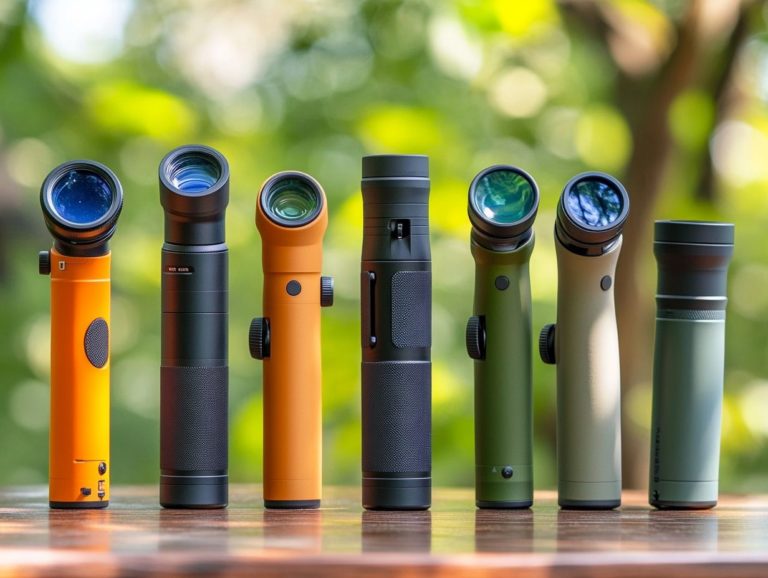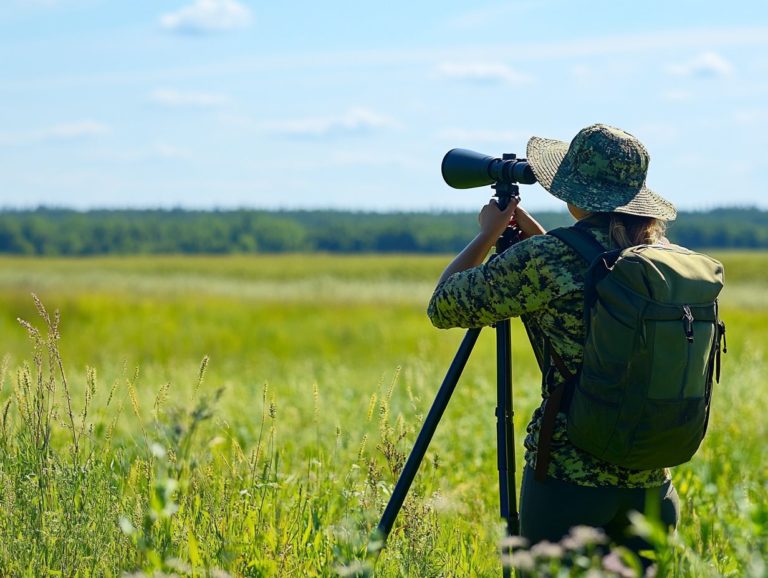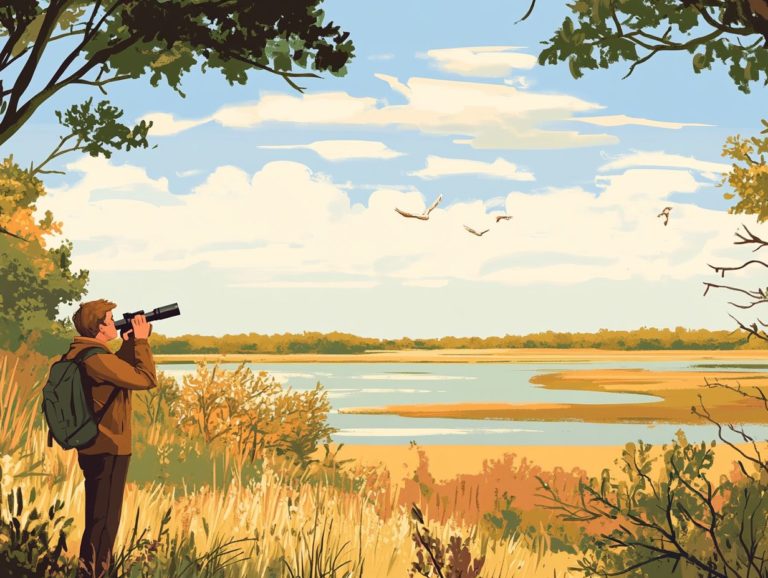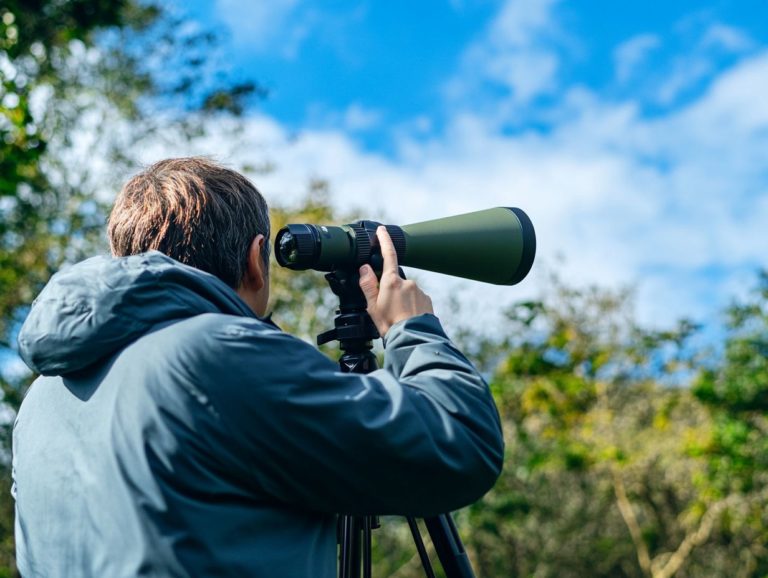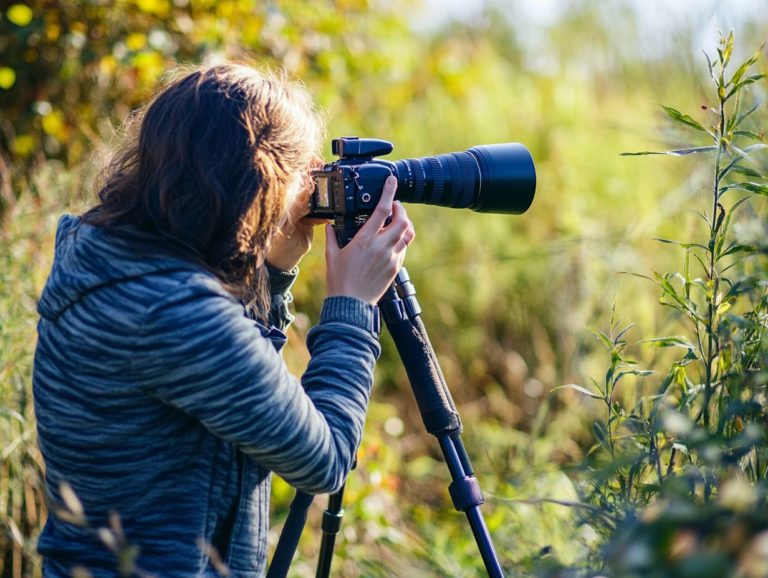How to Use Your Spotting Scope for Birdwatching at Night
Birdwatching at night unveils a mesmerizing world that many birdwatching fans tend to overlook.
With its own unique challenges and experiences, nighttime birdwatching calls for specialized gear and techniques. This article will guide you in selecting the right spotting scope, highlighting essential features for optimal night vision. You can also find tips for a successful and safe nighttime adventure! Prepare to uncover the enchanting magic of birdwatching beneath the stars!
Contents
- Key Takeaways:
- Choosing the Right Spotting Scope
- Preparing for Your Nighttime Birdwatching Trip
- Techniques for Spotting Birds at Night
- Final Thoughts on Nighttime Birdwatching
- Frequently Asked Questions
- What is a spotting scope and why is it useful for birdwatching at night?
- What features should I look for in a spotting scope for birdwatching at night?
- How do I set up my spotting scope for nighttime birdwatching?
- What tips should I follow for using a spotting scope at night?
- Can I use my spotting scope for nighttime birdwatching in all weather conditions?
- What precautions should I take when using a spotting scope at night?
Key Takeaways:
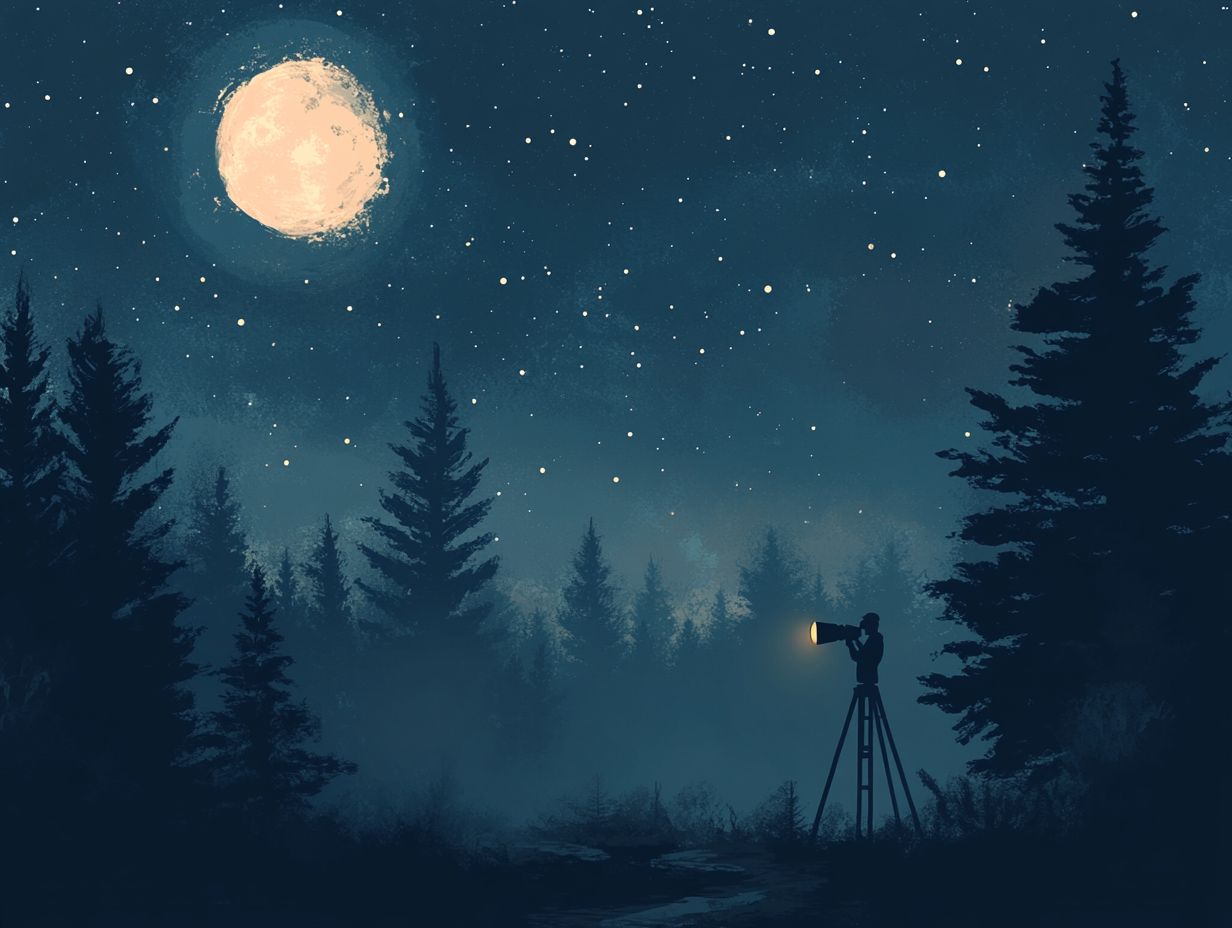
- Choose a spotting scope with night vision capabilities and essential features for successful nighttime birdwatching.
- Bring necessary gear and equipment, such as a headlamp and bird call recordings, to attract and identify birds at night.
- Plan your nighttime birdwatching trip for the best times and locations, and prioritize safety and comfort during your excursion.
Why Birdwatching at Night is Different
Nighttime birdwatching presents a distinctive experience, setting itself apart from the usual daytime observations. It calls for specialized techniques and equipment to spot birds under the dim glow of low light.
Without the sun’s guiding rays, you ll need stronger zoom levels and specific gear designed to adapt to various thermal conditions and distances. This makes for an exhilarating yet challenging pursuit for both birdwatching fans and bird scientists.
The type of birds you re observing, their behavior, and the tools at your disposal like spotting scopes and high-quality binoculars are all crucial elements that elevate your experience. Unlike the vibrant plumage that dazzles during the day, nocturnal birdwatching relies heavily on your keen instincts and a profound understanding of avian behavior.
The thrill of waiting for the soft hoots of owls or the subtle rustle of nightjars is an excitement that often surpasses what you encounter in daylight. You ll find that certain species display captivating behaviors under the cover of darkness, showcasing unique hunting strategies or intricate courtship rituals.
To truly immerse yourself in this thrilling nighttime adventure, investing in top-notch optics is essential. This not only allows for greater clarity and detail, even when moonlight is scarce, but it also transforms your experience, deepening your connection to the natural world.
Choosing the Right Spotting Scope
Selecting the perfect spotting scope is crucial for elevating your nighttime birdwatching experience as it directly influences your ability to appreciate the intricate details of birds in low light.
You ll want to consider factors like magnification range, the quality of the objective lens, and features such as a zoom eyepiece, waterproof capabilities, and adequate eye relief. All of these can greatly enhance the clarity and sharpness of your observations.
Furthermore, pairing your scope with a stable tripod will ensure optimal stability during use, enhancing both your viewing angles and the distance you can effectively observe.
Features to Look for in a Night Vision Scope
When you’re on the hunt for a night vision scope, keep in mind several crucial features that can elevate your birdwatching experience under the stars. Brightness and sharpness are key factors, as they directly influence your ability to pick out details in low-light conditions.
Evaluating the scope’s performance under varying thermal factors will help you determine its effectiveness in diverse environments. Whether you’re gazing at the stars over the Great Salt Lake or observing urban wildlife in bustling New York City, these elements matter.
High-quality optics are vital for enhancing these features, providing crisp, clear images even in challenging nocturnal settings. It’s also important to consider the scope’s ability to withstand different weather conditions, such as fog or rain, as this can greatly affect visibility.
Don t overlook the following:
- Lens coating
- Field of view
- Magnification capabilities
These elements work together to create a seamless birdwatching experience. By ensuring these factors align with your personal preferences and chosen birdwatching locales, you can fully immerse yourself in the captivating world of nocturnal feathered friends.
Preparing for Your Nighttime Birdwatching Trip
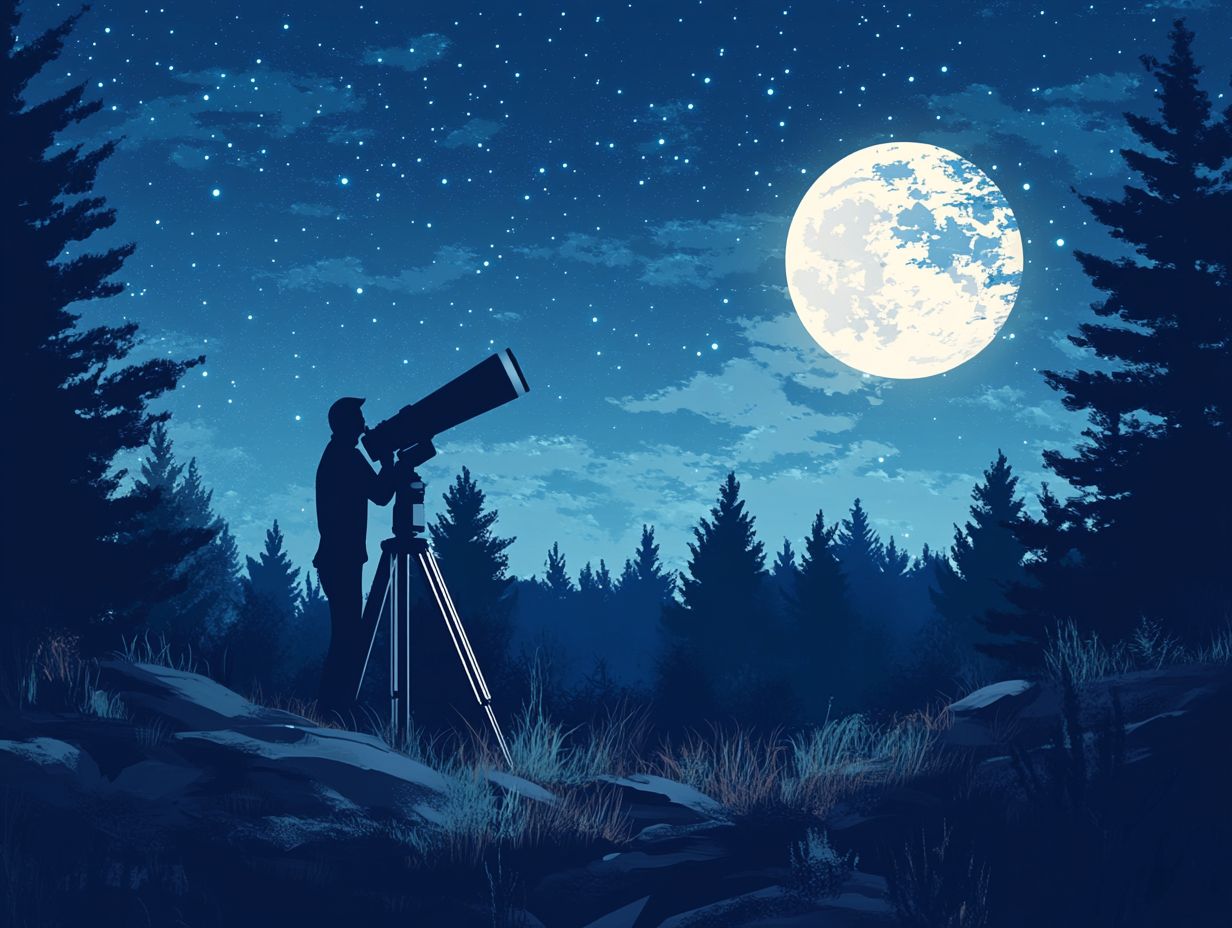
Prepare now for a thrilling nighttime adventure! Preparing for a nighttime birdwatching trip demands careful planning and a keen eye for essential gear.
Your checklist should include:
- High-quality spotting scope or binoculars
- Sturdy tripod
- Eyepiece covers
- Waterproof clothing
These items will enhance your effectiveness in the field. Learn how to adjust your focus like a pro for nighttime conditions, and you ll significantly boost your chances of encountering those elusive species.
Techniques for Spotting Birds at Night
Spotting birds at night combines various techniques that take advantage of the distinctive behaviors of nocturnal wildlife. By skillfully utilizing light and sound, you can enhance your chances of attracting and identifying various bird species, transforming nighttime observation into an enthralling experience.
Understanding the specific habits of your target birds such as their calls and movement patterns is essential for achieving success in your nighttime endeavors. For example, look for birds that are more active at night, such as owls.
Using Light and Sound to Attract Birds
Utilizing light and sound effectively can greatly enhance your ability to attract birds during your nighttime birdwatching expeditions. Employ subtle lighting techniques to illuminate specific areas, making them more inviting for nocturnal species.
Simultaneously, using recorded bird calls or other sounds can draw them closer to your location. This dual approach not only aids in spotting birds but also enriches your overall wildlife observation experience under the stars.
For instance, using a soft, red light can help avoid startling birds, allowing them to acclimate to their environment. Pair this with the gentle call of a screech owl or the trill of a common nightingale played at low volume through a portable speaker, and you ll create an irresistible ambiance.
Research indicates that frequencies around 4,000 to 6,000 Hz are particularly effective for mimicking the calls of songbirds, drawing them in from afar. Setting up your sound system near dense shrubbery or a water source can further improve your chances, as these areas are often frequented by various species seeking shelter or hydration during the night.
Don t wait; start planning your nighttime adventure today!
Identifying Birds by Their Calls
Identifying birds by their calls is an essential skill for nighttime birdwatching. It offers invaluable insights into the species that inhabit your observation area. By familiarizing yourself with common nocturnal bird calls and their meanings, you can elevate your wildlife observation experience. This skill allows you to pinpoint specific targets even in the dark.
Recognizing these sounds not only enhances the quality of your observations but also deepens your appreciation for the diverse bird life surrounding you. For example, the hoots of the Great Horned Owl or the haunting calls of the Eastern Whip-poor-will can act as auditory landmarks, guiding your understanding of local ecosystems.
If you’re just starting out, you might listen to recordings and practice in your backyard. Meanwhile, seasoned birdwatchers can refine their expertise by noting subtle variations in calls that indicate different behaviors or even breeding activities.
Recognizing these sounds can lead to more rewarding encounters. You can engage more meaningfully with nature while contributing to citizen science projects that track bird populations.
Tips for Successful Nighttime Birdwatching
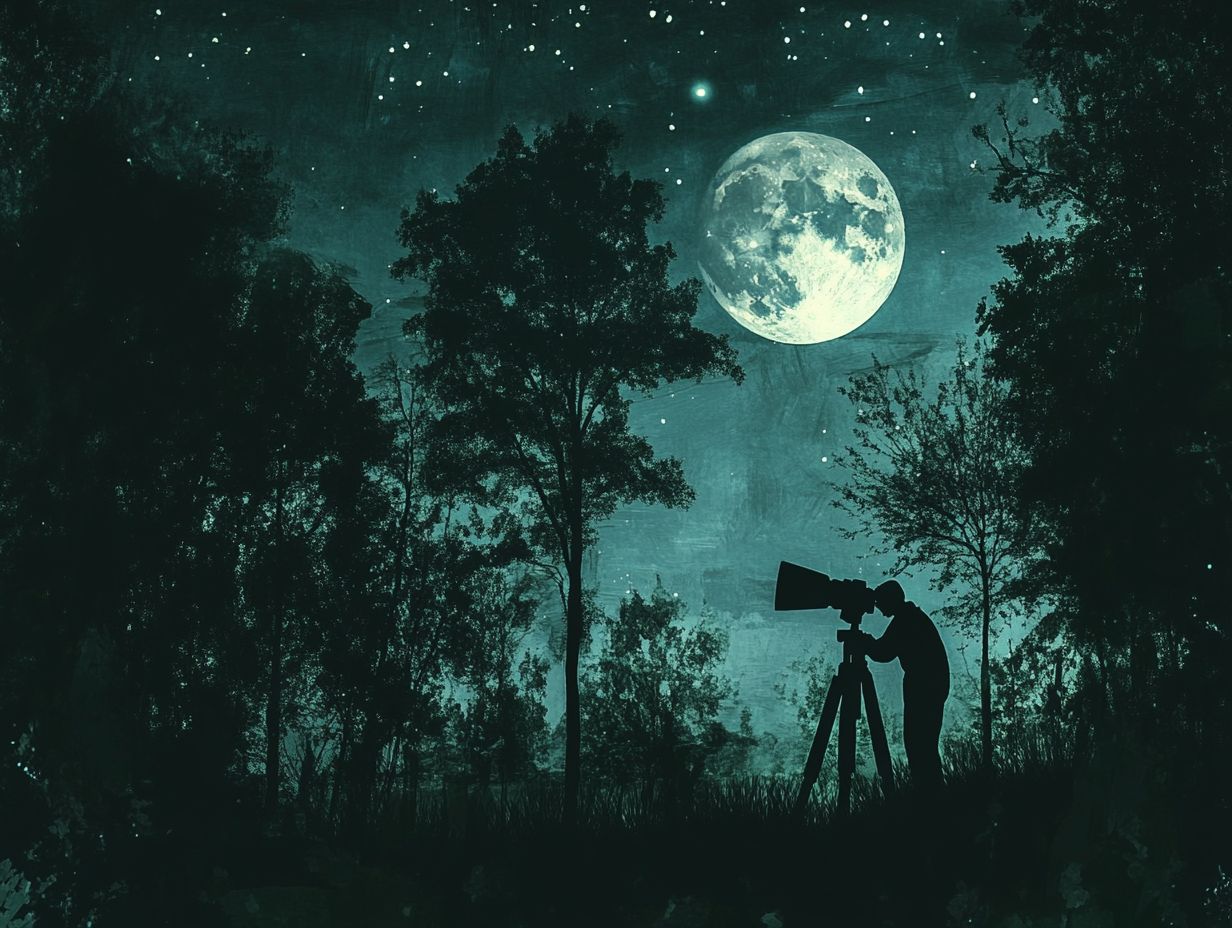
Success in nighttime birdwatching is all about blending strategy with preparation. This combination allows you to make the most of your observations while soaking in the tranquility of the night.
It’s essential to pinpoint the best times and locations for your birdwatching adventures. Some birds are particularly active during specific lunar phases or under certain weather conditions.
Familiarizing yourself with safety precautions and comfort techniques will enhance your experience and keep you secure as you delve into the enchanting world of nocturnal wildlife.
Best Times and Locations for Birdwatching at Night
Determining the best times and locations for nighttime birdwatching can significantly boost your chances of spotting a diverse array of species. Many birds are most active just after sunset and before sunrise, synchronizing their vocalizations and movements with specific feeding patterns.
Familiarizing yourself with local habitats like the mudflats at the Great Salt Lake or the wooded areas in New York City can open the door to unique birdwatching opportunities. Coastal regions, such as the Everglades in Florida, serve as an exceptional backdrop during migratory seasons, drawing in a wealth of shorebirds and waterfowl.
Autumn is particularly bountiful for observing nocturnal species, while wetlands come alive with a rich tapestry of bird life in spring. By understanding the interplay of light and habitat, you can enhance your nighttime excursions.
Immerse yourself in the enchanting symphony of calls that fill the air, especially in areas where fresh water meets lush flora. These conditions create ideal spots for bird activity and improve your field testing skills.
Staying Safe and Comfortable during Nighttime Birdwatching
Ensuring your safety and comfort during nighttime birdwatching is essential. This allows you to immerse yourself in the joy of observing wildlife without distractions. Thoughtful planning and selecting the right outdoor gear like waterproof clothing, sturdy footwear, and a dependable flashlight can significantly enhance your experience as you navigate unfamiliar terrains after dark.
Consider leveraging hunting optics for better visibility. Inform someone about your plans and stick to well-known paths to enrich your adventure and minimize potential risks.
Beyond the basics, bring extra batteries and a pair of binoculars specifically designed for low-light situations to elevate your viewing experience. High magnifications and models with quality glass can make a significant difference during your observations.
Always remain aware of the local wildlife to avoid unexpected encounters, as some creatures might be more active at night. Staying updated on weather conditions is equally crucial, as shifts can quickly alter your plans.
Bringing a friend along can elevate the enjoyment of your adventure while ensuring added safety in case of emergencies. These simple precautions help create a more rewarding and secure birdwatching outing under the stars.
Final Thoughts on Nighttime Birdwatching
Nighttime birdwatching is a thrilling adventure. Spotting rare nocturnal birds and enjoying the peaceful night atmosphere will take your birdwatching to the next level. This unique experience offers countless opportunities for wildlife observation, standing in stark contrast to daytime excursions. The excitement of spotting elusive nocturnal species using digiscoping a technique that involves using a camera attached to a telescope to capture images of birds elevates your pursuits to new heights.
As you plan your adventures, incorporate various tips and techniques, including a beginner s guide for novice birdwatchers. This will ensure successful outings and a lasting appreciation for the diverse world of birds.
While the darkness adds an element of mystery, it can also bring challenges like navigating unfamiliar terrain and ensuring your safety. Invest in quality binoculars designed specifically for low-light conditions. This investment will dramatically enhance your visibility and allow for more detailed observations of distant targets.
Don t forget to pack comfortable seating and warm clothing to create a cozy atmosphere. Lightweight options are easier to transport. By embracing the distinctive qualities of nighttime birdwatching, you will connect deeply with nature while refining your skills and understanding of avian behavior during these quieter hours.
Frequently Asked Questions
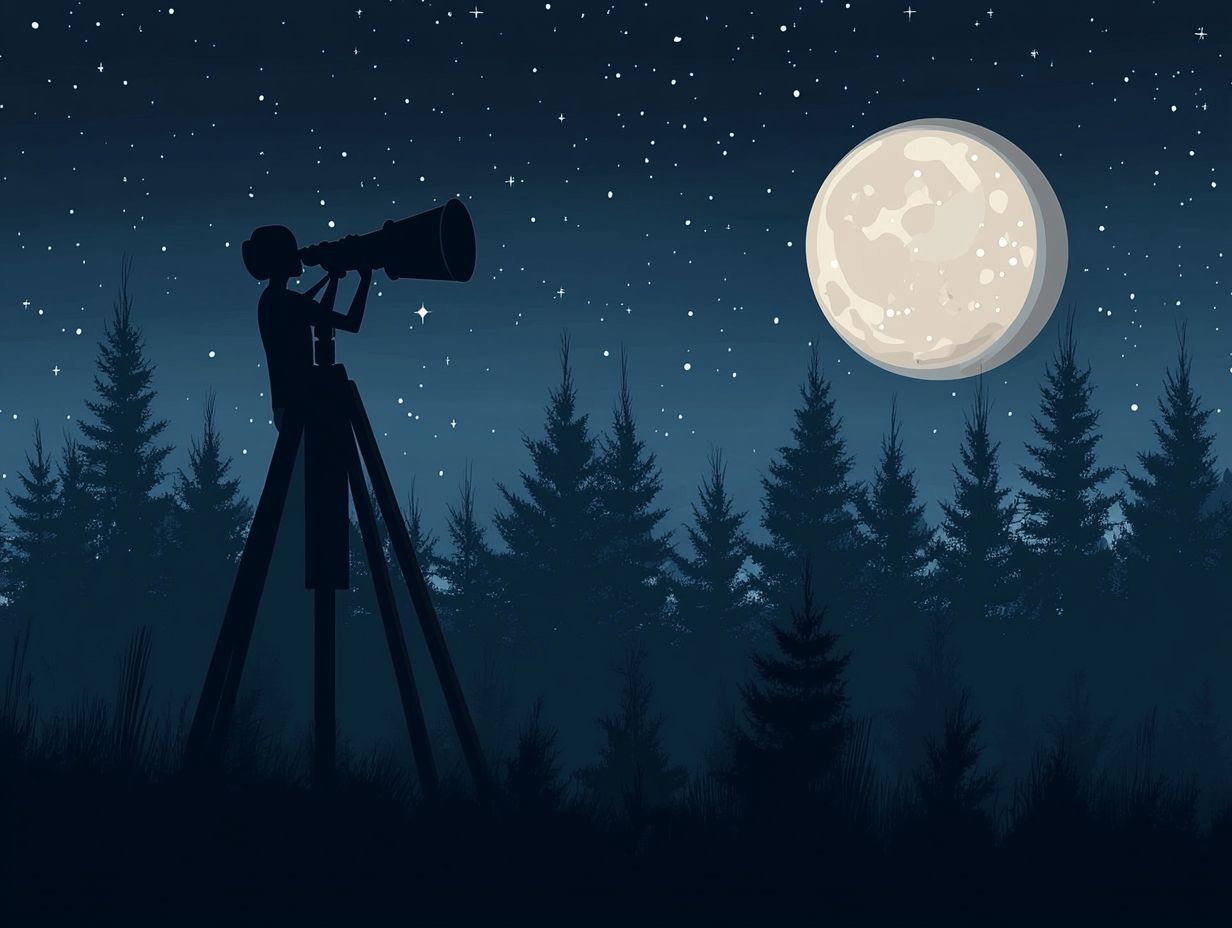
What is a spotting scope and why is it useful for birdwatching at night?
A spotting scope is a small, portable telescope designed for nature observation. It provides a clearer and more magnified view of distant birds, even in low light conditions, enhancing your viewing distance.
What features should I look for in a spotting scope for birdwatching at night?
When choosing a spotting scope for nighttime birdwatching, look for features like a large objective lens for better light gathering, a high magnification range, and a built-in night vision function for improved visibility. Additionally, exploring techniques for nighttime bird photography can enhance your experience. It’s also wise to consider models that are highly rated by professionals.
How do I set up my spotting scope for nighttime birdwatching?
First, find a stable surface or use a tripod to prevent shaky images. Adjust the focus knob to your desired magnification, and fine-tune the focus with the diopter adjustment. If available, activate the night vision function, and position yourself in a dark area for optimal viewing.
What tips should I follow for using a spotting scope at night?
Use a red filter on your flashlight to avoid disturbing birds with bright light. Stay hidden and avoid sudden movements to prevent scaring them away. Bring spare batteries and a lens cleaning kit to ensure your equipment is ready for use.
Can I use my spotting scope for nighttime birdwatching in all weather conditions?
It’s not advisable to use a spotting scope in heavy rain or fog, as these conditions can damage the equipment and reduce visibility. However, light rain and mist may not significantly impact your viewing experience.
What precautions should I take when using a spotting scope at night?
Be aware of your surroundings and avoid using the spotting scope near busy roads or in poorly lit areas. Secure your equipment properly to prevent it from falling or getting damaged.
Don t miss out on the enchanting beauty of nighttime birdwatching. Grab your gear and start your journey tonight!

